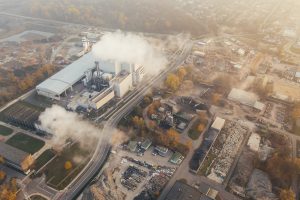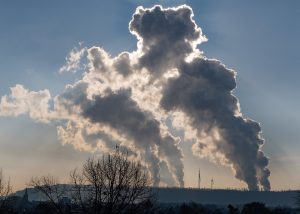 Attorney Shawn Collins, founder and partner of The Collins Law Firm in Naperville, Illinois, was instrumental in forging a $408 million settlement of the cancer claims of more than 800 plaintiffs in In re Willowbrook Ethylene Oxide Litigation, venued in Illinois State Court (Cook County). The claims arose after a federal government report announced in 2018 for the first time that a sterilization plant in Willowbrook, IL–operated by Sterigenics, LLC, and its predecessors–had been emitting a chemical known as ethylene oxide 24 hours a day into the residential community’s air for more than 30 years. Once it left the Sterigenics’ plant, the colorless, odorless ethylene oxide silently migrated a great distance, exposing people in homes, workplaces, and schools.
Attorney Shawn Collins, founder and partner of The Collins Law Firm in Naperville, Illinois, was instrumental in forging a $408 million settlement of the cancer claims of more than 800 plaintiffs in In re Willowbrook Ethylene Oxide Litigation, venued in Illinois State Court (Cook County). The claims arose after a federal government report announced in 2018 for the first time that a sterilization plant in Willowbrook, IL–operated by Sterigenics, LLC, and its predecessors–had been emitting a chemical known as ethylene oxide 24 hours a day into the residential community’s air for more than 30 years. Once it left the Sterigenics’ plant, the colorless, odorless ethylene oxide silently migrated a great distance, exposing people in homes, workplaces, and schools.
Ethylene oxide is widely used in the sterilization of medical devices and other items. It has been classified as a known human carcinogen by the International Agency for Research on Cancer (IARC) and the US Environmental Protection Agency (USEPA). It is especially dangerous to children.
Until the release of the government’s 2018 report, the residents of the Willowbrook area had never been told that such a dangerous chemical was infiltrating their community on a daily basis, or indeed at all. The more than 800 plaintiffs in the litigation were typically those who had been breathing the ethylene oxide—unknowingly—for years. After years of inhalation, most were then diagnosed with breast cancer, or lymphoma or leukemia—the cancers most strongly associated in medical studies with exposure to ethylene oxide.
 Illinois Personal Injury Lawyer Blog
Illinois Personal Injury Lawyer Blog



 Particulate matter is in the air all around us. Emitted from sources like industrial plants, fossil fuel burning, power plants, and wildfires – they are everywhere and can have dire consequences for human heart health. Regulatory agencies like the Environmental Protection Agency (EPA) are in place to ensure that things like particulate matter are kept sufficiently in check to protect American citizens. But are they doing enough to curb particulate matter to truly keep Americans safe?
Particulate matter is in the air all around us. Emitted from sources like industrial plants, fossil fuel burning, power plants, and wildfires – they are everywhere and can have dire consequences for human heart health. Regulatory agencies like the Environmental Protection Agency (EPA) are in place to ensure that things like particulate matter are kept sufficiently in check to protect American citizens. But are they doing enough to curb particulate matter to truly keep Americans safe? Just weeks after America witnessed a black plume of toxic murk billowing above East Palestine, the Surface Transportation Board inexplicably decided to increase the chance of an identical derailment horror, right here in the Chicago area.
Just weeks after America witnessed a black plume of toxic murk billowing above East Palestine, the Surface Transportation Board inexplicably decided to increase the chance of an identical derailment horror, right here in the Chicago area.  If you spend any time on the websites of the leading defense contractors with the U.S. Department of Defense – Lockheed Martin
If you spend any time on the websites of the leading defense contractors with the U.S. Department of Defense – Lockheed Martin Procter & Gamble has issued a voluntary product recall of more than 30 aerosol spray dry shampoos and dry conditioners, warning that the products could contain benzene, a cancer-causing chemical linked to leukemia.
Procter & Gamble has issued a voluntary product recall of more than 30 aerosol spray dry shampoos and dry conditioners, warning that the products could contain benzene, a cancer-causing chemical linked to leukemia.

 UPDATE: The Collins Law Firm. P.C. and Miner Barnhill & Galland, P.C. have filed a class action lawsuit against Chemtool Incorporated on behalf of residents affected by the explosion and fire that caused them to be evacuated from the area.
UPDATE: The Collins Law Firm. P.C. and Miner Barnhill & Galland, P.C. have filed a class action lawsuit against Chemtool Incorporated on behalf of residents affected by the explosion and fire that caused them to be evacuated from the area. COVID-19 has had disastrous effects on humans around the globe. It has killed thousands, left even more in financial despair, and infected millions of people worldwide. However, it does not come without a silver lining. As a result of coronavirus-related shutdowns, air pollution, which plays a major role in whether those infected with COVID-19 live or die, is at its lowest level in years. If we pay close enough attention, this pandemic can also function as a learning moment for the climate crisis.
COVID-19 has had disastrous effects on humans around the globe. It has killed thousands, left even more in financial despair, and infected millions of people worldwide. However, it does not come without a silver lining. As a result of coronavirus-related shutdowns, air pollution, which plays a major role in whether those infected with COVID-19 live or die, is at its lowest level in years. If we pay close enough attention, this pandemic can also function as a learning moment for the climate crisis. In the summer of 2008, the Chinese city of Beijing hosted the Olympic Games. The event has frequently been called the most polluted Olympics ever and many remember seeing the images of Beijing skyscrapers barely visible through a thick layer of hazy smog. What many Americans may not know, however, is that the same type of air pollution from Particulate Matter emissions has been linked to the premature deaths of many women and men right here in the United States.
In the summer of 2008, the Chinese city of Beijing hosted the Olympic Games. The event has frequently been called the most polluted Olympics ever and many remember seeing the images of Beijing skyscrapers barely visible through a thick layer of hazy smog. What many Americans may not know, however, is that the same type of air pollution from Particulate Matter emissions has been linked to the premature deaths of many women and men right here in the United States.